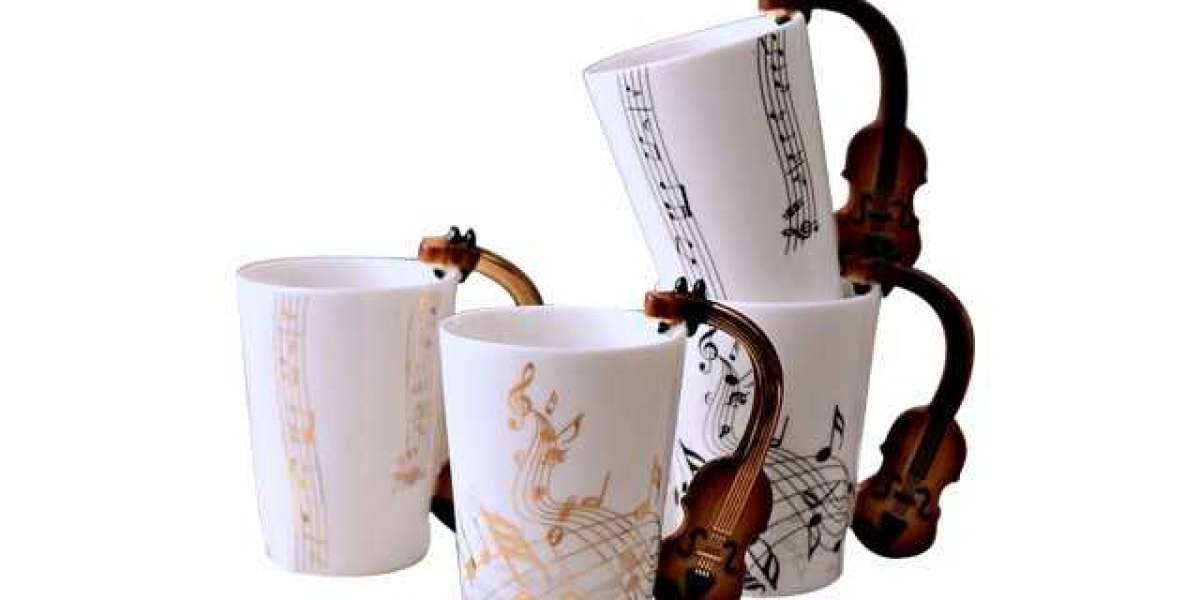The main raw material of ceramic mugs is mud. Ceramic Mug is also called Ceramic Cup, Porter Mug, and Pottery Cups. Neither destroy resources nor pollute the environment. The selection of ceramic cups reflects the awareness of environmental protection and the care of our living environment. The ceramic mug is environmentally friendly, durable, and practical. Ceramic cups have become indispensable daily necessities in our lives.
There are different kinds of ceramic mugs. The white ceramic mug painted with no color glaze is not only safe in material, and high-temperature resistance, but also has a relatively good thermal insulation effect. It is a good choice for drinking hot water, coffee, or tea.
Ceramic Marbled Cups
The marble pattern is natural in color and the texture is smooth and clear. With golden strokes, the ceramic mug is generous and delicate. Soft to the touch and full of color, it is used to hold milk, coffee, etc.
Ceramic Mugs With Lid and Spoon
The polygonal ceramic coffee mug with a golden handle is noble and formal without being old-fashioned. It is a good choice for the office or home leisure. The styles are simple and stylish, and the color is full and bright.
Ceramic Cups Temperature
According to the temperature, ceramic cups can be divided into low-temperature ceramic cups, medium-temperature ceramic cups, and high-temperature ceramic cups.
Difference Between Different Temperature Ceramic Cups
Temperature: The firing temperature of high-temperature porcelain is above 1200 degrees. The firing temperature of medium-temperature porcelain is 1000-1150 degrees. The firing temperature of low-temperature porcelain is 700-900 degrees.
Color: The color of high-temperature porcelain is fuller, more delicate, and crystal clear. The color of medium and low-temperature porcelain is relatively dull.
Tactile Impression: high-temperature porcelain is smooth and delicate. Medium and low-temperature porcelain is slightly rough.
Voice: High-temperature porcelain is relatively crisp. Medium and low-temperature porcelain is relatively low stuffiness.
Texture: High-temperature porcelain has a firmer hardness. Medium and low-temperature porcelain is more brittle.
Water Absorption Rate: The most obvious difference between high-temperature ceramics and medium and low-temperature ceramics is the water absorption rate. The water absorption rate of medium and low-temperature ceramics is higher, and the water absorption rate of high-temperature ceramics is less than 0.2%.
High-temperature ceramic travel mugs are easy to clean, will not absorb odors, and will not cause cracks on the glaze and local water leakage.
Ceramic Mugs Structure
Ceramic coffee cups can be divided into Single-layer Ceramic Mugs and Double Walled Ceramic Mugs according to their structure.
Ceramic Cups Category
Ceramic cups can be divided into ceramic keep cups, ceramic insulated cups, ceramic coffee cups, and ceramic energy health cups by category.
Ceramic coffee cups must not react chemically with coffee, so reactive metals must not be used as coffee cups, such as aluminum cups. The body of the coffee cup should be thick, and the mouth of the cup should not be wide open. The cup condenses the heat of the coffee, and it is not easy to cool down quickly, so as not to affect the taste and taste of the coffee.
The energy health cup is weakly alkaline, which can eliminate acidic metabolites in the body, eliminate tobacco poison and alcohol, remove excess fat, regulate the acid-base balance of the human body, and prevent diseases.
The ceramic energy cup has small molecular clusters, it can improve the microcirculation of the human body, clear the bowels, accelerate the excretion of toxins in the body, and promote metabolism. A negative potential can remove excess free radicals in the body and delay aging. With high oxygen content, it can provide oxygen and nutrients needed by human cells and enhance immunity.
The ceramic energy health cups contain minerals and trace elements in appropriate proportions, which are easy for the body to absorb and promote health. Containing negative ions can kill viruses and bacteria in body fluids, purify the blood, eliminate fatigue, and regulate the gastrointestinal system.



